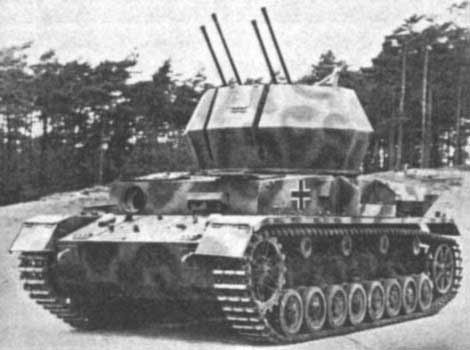This is the first in a series of articles on German tanks of World War II. I’m starting with the Panzer IV which was the mainstay of Wehrmacht and Waffen SS Panzer Formations throughout the war. The series will appear periodically over the next month.
The Panzer IV tank was unique among the Armored Fighting Vehicles of the Second World War in that it served in a front line role throughout the entire conflict. No other tank in service in 1939 was still in front line service in 1945, a fact that shows the dependability, versatility and quality of the Panzer IV.
The Panzer IV was developed in 1934 out of a requirement for a medium tank to operate in a support and anti-infantry role. It was meant to compliment the lighter Panzer II and Panzer III and the design requirements did not require the new tank engage enemy tanks on equal terms. The Wehrmacht submitted its requirements and Krupp, Rheinmetall and MAN produced prototypes for evaluation and testing following which the Krupp version was selected for production.
The new tank mounted a low velocity L24/ 75mm gun had a crew of 5. The Panzer IV had a maximum speed of 35 km/hour. The first three variants of the Panzer IV the Ausf A, B and C were developmental models. These limited production models with a total production of just over 200 vehicles were primarily used for training the fledgling Panzerwaffe. As the Wehrmacht had a need for more tanks many of these were provided additional armor and placed in front line units until phased out of service. The Panzer IV D which was first produced in 1939-1940 was the first of the series designed for combat and issued to the Panzer Divisions. One drawback of this model was that it had weak armor protection. This deficiency was corrected to some degree in the next model, the Ausf E which was produced from 1940-1941. Neither the Panzer IV D or E variants were produced in great numbers with fewer than 500 units produced.
Limited numbers were used in the annexation of Austria and it first saw combat in Poland followed by the Blitzkrieg across France, North Africa, the Balkans and the Soviet Union. It was in France and North Africa where the Germans ran up against French Char B heavy tanks and British Matilda Infantry tanks that they found that the gun power of the Panzer IV was inadequate to penetrate the heavy armor of these opponents. Despite this the Germans maintain the low velocity gun on the next model, the Panzer IV F1 when it was introduced in 1941. When the Germans encountered the Red Army’s T-34 and KV-1 tanks during Operation Barbarossa they finally decided to equip the tank with a L43/ 75mm gun. This was sufficient to deal with any allied tank. The first model to use this was the Panzer IV F-2 which rolled out in late 1941, of which nearly 500 were produced.
 Panzer IV H with Additional Side and Turret Armor to protect against shaped projectiles
Panzer IV H with Additional Side and Turret Armor to protect against shaped projectiles
The continued need for improvements in response to combat conditions on the Eastern Front and North Africa meant that the F-2 was further refined in the Panzer IV G in 1942. The Mark IV G was the first model to be produced in large numbers with over 1600 units produced. The Mark IV G was superseded by the Panzer IV H which had a more powerful L/48 75mm gun.
Jagdpanzer IV with Long L/70 75mm gun
Each succeeding models armor protection was improved and beginning with the Mark IV G turret and side skirt armor was applied as protection against hollow charge projectiles. The Mark IV H which was produced from1943 to1944 had a production run of nearly 3800 units. The final model, the Mark IV J was produced in 1944-1945 with a total production run of about 1750 units.
 Flak Pz IV Wirbelwind with 4x 20mm Flak
Flak Pz IV Wirbelwind with 4x 20mm Flak
The Panzer IV served on every Front and was provided to Romania, Hungary and Finland in limited numbers. It remained a formidable opponent to allied armor and was found in elite formations of the Wehrmacht and Waffen SS until the end of the war, despite being superseded by the newer and more powerful Panther. It was prized for its reliability and could engage or almost every allied tank on equal or superior terms up to the end of the war. The long L 43/48 gun and side armor on the turret sometimes led the Panzer IV G, H and J to be confused by allied tank crews with the Tiger I. The chassis was modified to serve in a number of roles including the Jadgpanzer IV, a tank killer equipped with the Panther’s L/70 75mm gun forward mounted in a limited traverse mount.
Likewise the Sturmgeschutz IV assault gun was developed by the Artillery as a infantry support and anti-tank vehicle. Several FLAK versions including the Wirbelwind quad 20mm anti-aircraft tank were introduced to provide anti-aircraft support to the Panzers against allied fighter bombers while and a number of other specialized support versions, bridge layers, artillery support vehicles, command vehicles and some designed to support very esoteric super-weapon projects like the “Land Cruiser” were produced in limited numbers. After the war some Panzer IVs saw continued service in Finland, Hungary, and Romania and well after the war by Syria where they served in a dug in defensive mode during the Six Day War.








